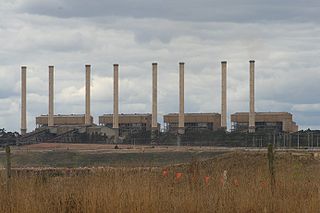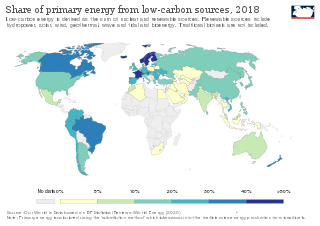
Coal is a combustible black or brownish-black sedimentary rock, formed as rock strata called coal seams. Coal is mostly carbon with variable amounts of other elements, chiefly hydrogen, sulfur, oxygen, and nitrogen. Coal is formed when dead plant matter decays into peat and is converted into coal by the heat and pressure of deep burial over millions of years. Vast deposits of coal originate in former wetlands—called coal forests—that covered much of the Earth's tropical land areas during the late Carboniferous (Pennsylvanian) and Permian times. However, many significant coal deposits are younger than this and originate from the Mesozoic and Cenozoic eras.

Electricity generation is the process of generating electric power from sources of primary energy. For utilities in the electric power industry, it is the stage prior to its delivery to end users or its storage.
Southern Company is an American gas and electric utility holding company based in the southern United States. It is headquartered in Atlanta, Georgia, with executive offices also located in Birmingham, Alabama. The company is currently the second largest utility company in the U.S. in terms of customer base. Through its subsidiaries it serves 9 million gas and electric utility customers in 6 states. Southern Company's regulated regional electric utilities serve a 120,000-square-mile (310,000 km2) territory with 27,000 miles (43,000 km) of distribution lines.
The spark spread is the theoretical gross margin of a gas-fired power plant from selling a unit of electricity, having bought the fuel required to produce this unit of electricity. All other costs must be covered from the spark spread. The term was first coined by Tony West's trading team on the trading floor of National Power Ltd in Swindon, UK during the late 1990s and quickly came into common usage as other traders realised the trading and hedging opportunities.

A fossil fuel power station is a thermal power station which burns a fossil fuel, such as coal or natural gas, to produce electricity. Fossil fuel power stations have machinery to convert the heat energy of combustion into mechanical energy, which then operates an electrical generator. The prime mover may be a steam turbine, a gas turbine or, in small plants, a reciprocating gas engine. All plants use the energy extracted from expanding gas, either steam or combustion gases. Although different energy conversion methods exist, all thermal power station conversion methods have efficiency limited by the Carnot efficiency and therefore produce waste heat.

The Bełchatów Power Station is a coal-fired power station near Bełchatów, Poland. It is the largest thermal power station in Europe and the world's most carbon polluting. The power station is owned and operated by PGE GiEK Oddział Elektrownia Bełchatów, a subsidiary of Polska Grupa Energetyczna.

Coal pollution mitigation, sometimes called clean coal, is a series of systems and technologies that seek to mitigate the health and environmental impact of coal; in particular air pollution from coal-fired power stations, and from coal burnt by heavy industry.

The Hazelwood Power Station is a decommissioned brown coal-fuelled thermal power station located in the Latrobe Valley of Victoria, Australia. Built between 1964 and 1971, the 1,600-megawatt-capacity power station was made up of eight 200MW units, and supplied up to 25% of Victoria's base load electricity and more than 5% of Australia's total electricity demand. It was a 'subcritical' pulverized coal-fired boiler. The station was listed as the least carbon efficient power station in the OECD in a 2005 report by WWF Australia, making it one of the most polluting power stations in the world. At 1.56 tonnes of CO2 for each megawatt hour of electricity, it was 50% more polluting than the average black coal power station in New South Wales or Queensland. Hazelwood emitted 14% of Victoria's annual greenhouse gas emissions and 3% of Australia's greenhouse gas emissions.

The Capitol Power Plant is a fossil-fuel burning power plant which provides steam and chilled water for the United States Capitol, the Supreme Court, the Library of Congress and 19 other buildings in the Capitol Complex. Located at 25 E St SE in southeast Washington, D.C., it is the only coal-burning power plant in the District of Columbia, though it mostly uses natural gas. The plant has been serving the Capitol since 1910, and is under the administration of the Architect of the Capitol. Though it was originally built to supply the Capitol complex with electricity as well, the plant has not produced electricity for the Capitol since 1952. Electricity generation is now handled by the same power grid and local electrical utility (Pepco) that serves the rest of metropolitan Washington.

WEC Energy Group is an American company based in Milwaukee, Wisconsin that provides electricity and natural gas to 4.4 million customers across four states.

The Robert W. Scherer Power Plant is a coal-fired power plant in Juliette, Georgia, just north of Macon, Georgia, in the United States. The plant has four generating units, each capable of producing 930 megawatts, and is the most powerful coal-fired plant in North America. The plant is named after the former chairman and chief executive officer of Georgia Power.

Coal power in the United States generates about 20% of the country's electricity. It accounted for 39% of production at utility-scale facilities in 2014, 33% in 2015, 30.4% in 2016, 30.0% in 2017, 27.4% in 2018, 23.5% in 2019, and 19.3% in 2020. Coal supplied 12.6 quadrillion Btu (3,700 TWh) of primary energy to electric power plants in 2017, which made up 91% of coal's contribution to US energy supply. Utilities buy more than 90% of the coal consumed in the United States.

Low-carbon power is electricity produced with substantially lower greenhouse gas emissions than conventional fossil fuel power generation. The energy transition to low-carbon power is one of the most important actions required to limit climate change. Power sector emissions may have peaked in 2018. During the first six months of 2020, scientists observed a 8.8% decrease in global CO2 emissions relative to 2019 due to COVID-19 lockdown measures. The two main sources of the decrease in emissions included ground transportation (40%) and the power sector (22%). This event is the largest absolute decrease in CO2 emissions in history, but emphasizes that low-carbon power "must be based on structural and transformational changes in energy-production systems".

Edgewater Generating Station is a 380 megawatt (MW) coal power plant located in Sheboygan, Wisconsin. It provides electricity for customers in the northeastern part of Alliant Energy's Wisconsin Power & Light service area and service to several local municipal utilities. In 2009, it was the seventh largest generating station in Wisconsin, with a net summer capacity of 767 MW.
Carbon capture and storage (CCS) is a technology that can capture carbon dioxide CO2 emissions produced from fossil fuels in electricity, industrial processes which prevents CO2 from entering the atmosphere. Carbon capture and storage is also used to sequester CO2 filtered out of natural gas from certain natural gas fields. While typically the CO2 has no value after being stored, Enhanced Oil Recovery uses CO2 to increase yield from declining oil fields.
The Kędzierzyn Zero-Emission Power and Chemical Complex is a proposed facility in Kędzierzyn-Koźle, Poland. It will combine power and heat generation with that of chemical products and carbon capture and storage. The project is proposed by a consortium of chemicals producer Zakłady Azotowe Kędzierzyn and electricity company Południowy Koncern Energetyczny. The plant will produce synthesis gas by gasification of hard coal. The produced gas will be used for power and heat generation or for production of chemicals. The plant will capture produced carbon dioxide (CO2), which will be stored in natural geological reservoirs or used as a raw material for production of synthesis fuels, fertilisers or plastics.

Different methods of electricity generation can incur significantly different costs, and these costs can occur at significantly different times relative to when the power is used. The costs include the initial capital, and the costs of continuous operation, fuel, and maintenance as well as the costs of de-commissioning and remediating any environmental damage. Calculations of these costs can be made at the point of connection to a load or to the electricity grid, so that they may or may not include the transmission costs.
Prairie State Energy Campus is a 1,600 megawatt base load, coal-fired, electrical power station and coal mine near Marissa, Illinois southeast of St. Louis, Missouri. Prairie State Energy Campus (PSEC) features low levels of regulated emissions compared to other coal-fired power stations, capturing sulfur from high-sulfur coal mined nearby instead of transporting low-sulfur coal from elsewhere.

The Kemper Project, also called the Kemper County energy facility or Plant Ratcliffe, is a natural gas-fired electrical generating station currently under construction in Kemper County, Mississippi. Mississippi Power, a subsidiary of Southern Company, began construction of the plant in 2010. The initial, coal-fired project was central to President Obama's Climate Plan, as it was to be based on "clean coal" and was being considered for more support from the Congress and the incoming Trump Administration in late 2016. If it had become operational with coal, the Kemper Project would have been a first-of-its-kind electricity plant to employ gasification and carbon capture technologies at this scale.

The Sherburne County Generating Station, also known as Sherco, is a large coal-fired power plant on the banks of the Mississippi River in Becker, Minnesota, which is in Sherburne County. Its three units have a combined capacity of 2,238 megawatts, making it the largest power plant in the state. In comparison, the single-unit Monticello Nuclear Generating Plant located less than four miles away has an output of 671 MW. The state's other nuclear power plant, the 2-unit Prairie Island facility, is rated at 1,096 MW, so Sherco has a larger peak output than those plants put together. The station uses 20,000 to 30,000 tons of coal per day. The BNSF Railway delivers up to three 115-car trains per day from mines in the Powder River Basin.















